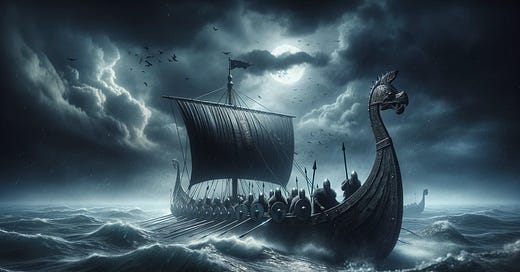Understanding Viking Slavers of a Thousand Years Ago
In this special feature post, we explore a crucial but often overlooked aspect of the era: Viking slavers. A thousand years ago, Viking raiders were not just explorers and warriors but also participants in the slave trade, a brutal and complex part of their culture. This post delves into the life of Viking slavers, aiming to provide a deeper understanding of the challenges and harsh realities they faced.
Pursuit of Wealth: Raids and Slavery
The Vikings, known for their seafaring prowess, often raided coastal towns and monasteries, primarily in pursuit of wealth. Slavery was a significant part of this. Capturing men, women, and children during raids, they sold these individuals in slave markets across Europe and beyond. For Viking slavers, human captives were commodities that could bring substantial profit.
The drive to brutally exploit others was a key part of pre-Christian Nordic culture, what we now call Viking culture. Love thy neighbour was not a big thing in those days.
The Viking attack of 8 June 793 CE that destroyed the abbey on Lindisfarne, a centre of learning on an island off the northeast coast of England, is regarded as the beginning of the Viking Age.
1066 is regarded as the end though it did linger in places. Christian priests and monks helped in ending the widespread practice of slavery.
Dublin, which features in the series I am writing, was a key slave trading port at that time. Nordic raiders had established the town partly to allow raiding inland and the capturing of young men and women to be sold for profit. By 1066 the great Viking raiding era was almost over, but the kings of Dublin and Leinster allowed slave trading to continue as it was highly lucrative. It was the Normans who finally abolished it in Ireland after they invaded and took control over a hundred years later.
Brutality and Control
Life for captives under Viking control was harsh and unforgiving. Abuse and mistreatment were common, as the primary goal of the slavers was to maintain control and prevent escape or rebellion. Captives were often bound; the unruly wore neck rings and some were castrated or had ears or noses cut off. Not a pretty sight. Individual treatment depended largely on the temperament and attitudes of the captors. The Vikings' reputation for brutality often preceded them, instilling fear and compliance in captives.
Dealing with Insurrections
Despite the fear and control, insurrections did occur. Captives, driven by desperation and the human will to be free, sometimes rebelled against their captors. Viking slavers had to be constantly vigilant and were often brutal in quelling these uprisings, as any sign of weakness could spark further rebellion.
Harsh Cultural Norms
Viking society itself was built on strict cultural norms that valued strength, honor, and loyalty. Slavers were often warriors themselves, adhering to a code that celebrated martial prowess and conquest. However, this culture also meant that any failure or loss of face, such as losing control of captives or failing in a raid, could have serious consequences for their status within their community.
Threats of Theft and Revenge
The life of a Viking slaver was fraught with external threats. There were always others looking to steal their "property" or profit from their raids. Furthermore, they faced the constant threat of revenge from the communities they raided or the families of those they enslaved. This necessitated a life of constant vigilance and readiness for conflict.
The Human Cost
Raids and the slave trade left a trail of suffering and disruption in communities across Europe. Families were torn apart, and the psychological and physical scars of enslavement were profound and long-lasting.
Understanding the life and times of Viking slavers gives us context to the broader historical landscape of a thousand years ago. It’s a reminder of the complex and brutal aspects of our past, aspects that shaped the world in which real people found themselves.
Please share your thoughts and questions in the comments below.






This is very interesting Laurence, shedding light on a little known aspect of Viking culture. Here in Ireland we tend to regard the Vikings as heroic and semi-mythical and not as colonisers, which of course they were. Ownership of slaves was obviously a universal phenomenon, and a badge of shame too.